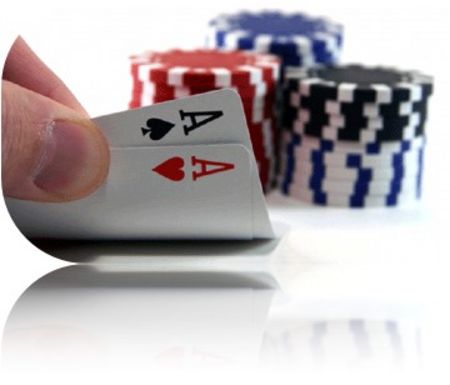Betting the Turn

In the previous two sections, we discussed what you should do when you were the
aggressor before the turn. Sometimes you have the opportunity to become the
aggressor by either betting out or raising a strong hand or as a bluff.
Let's look at when you must act first and have a big hand from either slowplaying
the flop or hitting a draw on the turn. The two most common options available to
you are betting out or trying a check-raise (in rare cases you might simply check
and call as a possible slowplay to the river).
An important consideration between the two options is whether or not you expect
an opponent to bet behind you. As discussed previously, it can be disastrous to
give a free card on the turn; however, check-raises can be an effective strategy,
especially against aggressive opponents who you are relatively confident will bet
the turn. On the other hand, sometimes you might bet out hoping to be raised so
that you can reraise.
Let's look at a couple of examples. You hold 7 ♦ 7 ♣ in both of them. In the first
example, the board is A ♦ T ♦ 7 ♥ 2 ♣. You called preflop from early position and were
raised by a middle position player. You checked and called on the flop as a
slowplay. Check-raising the turn in this type of situation can be a good play since
there is a decent chance that your opponent will bet again with this board. Even if
he doesn't bet with a hand like KK or QQ, a free card is not too risky. Another
option is to bet oat hoping that your opponent raises with a hand like AK or AQ so
that you can reraise.
Let's say you have the same hand, but this time the board is A ♦ T ♦
7 ♥ 2 ♦. The
board is now three-suited. If your opponent has K ♦ K ♣ or Q ♦ Q ♣, he may be more
inclined to check the turn and take a tree card with his draw to the flush; therefore,
betting out is probably the best option against most opponents.
If you are acting behind your opponents and it is checked to you, it is almost
mandatory to bet a strong hand. You generally don't want to give a free card to your
opponents and you want to gain bets with your good hands. Again, there are some
rare limes when checking may be considered as a slowplay with a small pot (see
Staying the Aggressor with Strong Hands section), but in most cases you should
bet out your hand.
The other time you might bet the turn is as a bluff or semi-bluff. Sometimes you can
bet out if you sense there is a decent chance your opponents will fold. If your
opponents check, a bet could win the pot since they have indicated weakness.
Sometimes a scary turn card will allow a bet to be successful. For example,
whenever an ace comes, the board pairs, or a third suited card comes, you might
bet out hoping that your opponents will fold. Remember that semi-bluffs are more
successful against a lone opponent than several.
NEXT...Raising the Turn

